I believe intersectionality to be the most important aspect of diversity, equity, and inclusion (DEI) but it seems to be the least talked about. Efforts in my own town have decided to prioritize different areas but completely ignore others. I saw several variations that depicted a wheel of privilege and none of them seemed exhaustive enough or they felt misguided when their wedges overlapped as members from those marginalized communities provided input into what their slices should look like.
So I tried my hand at making my own interpretation based on the original content, different interpretations of that content, the feedback I received, and my own experiences and opinions.
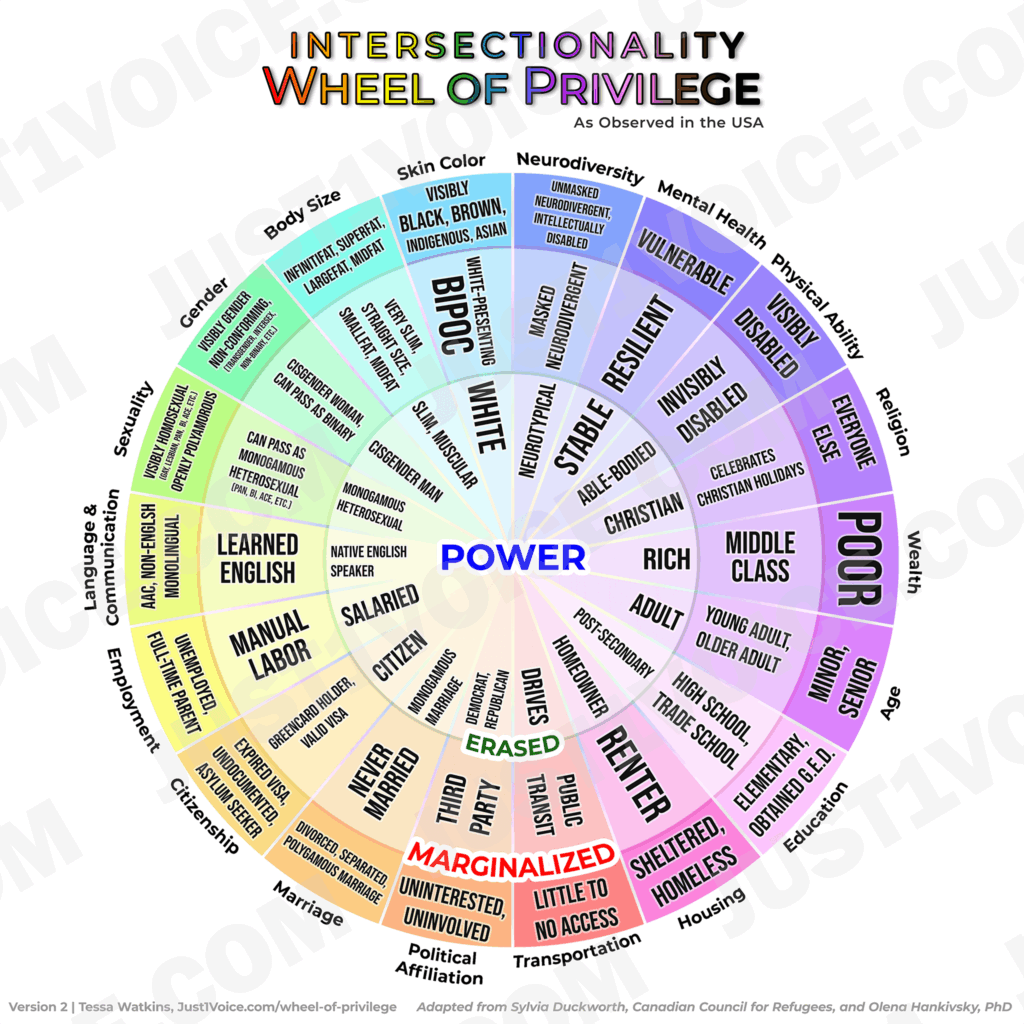
Keep in mind that this wheel is dynamic. If you decide to plot your identity, it probably won’t be the same every time you do it. Circumstances change, money comes and goes, life happens. Some aspects of your life are permanent, but even if everything stayed the same, your age wouldn’t.
Some people straddle multiple rings for a single demographic category, bisexuals for example. While your sexual orientation may not change, your partners might. Therefore people treat you differently based on how they perceive your relationship. If you can pass as the hegemonic power, you may experience that privilege. If you don’t, you may experience discrimination.
The Spectrum of Power and Privilege
The biggest difference between my wheel of privilege and the previous adaptations is that each demographic category, or wedge of the wheel, has three (3) rings: power, erased, and marginalized. Some acknowledged this spectrum of power, but I’ve specifically put a label on these simplified levels. I wanted to acknowledge the identities of those that experience erasure.
The Ring of Power
One ring to rule them all: the innermost ring is the most privileged/powerful. The people who take up space in this ring, especially if they exist in multiple wedges of the innermost ring, will have the most power in any room. That means their opinions will be listened to and considered more often than others.
This is where allyship is important. If you’re a privileged and/or powerful person and you’re in the room with someone that isn’t, your job as an ally is to make space for them, amplify their voice, and listen. If they aren’t in the conversation, that is the only time when it is appropriate for you to speak on their behalf. Also, ask yourself why they’re not part of the discussion and look for ways to invite them to it.
Erasure
The middle ring is often the forgotten ring (think “middle child syndrome” but on a societal scale). People in this area often have their identities erased and are marginalized in unique ways. The people that exist on either extreme see those in the middle as “passable” for the other extreme. Essentially, it is believed that they can “choose” to be marginalized or privileged when it benefits them.
This is an incredibly hurtful myth because your place within these rings is rarely by choice. This is where most of the covert discrimination exists through dismissal and minimization, often from both sides. People in this area are valid; their opinions and experiences are just as valuable as those who “have it worse.”
Marginalized Identities
The outermost ring is the most marginalized because these people experience more overt discrimination (in addition to the covert stuff) than the other rings. In areas where erased identities can pass, marginalized people cannot and are often affected the most by systemic discrimination.
It is also no surprise that in America, these identities are underrepresented everywhere unless for a specific, usually negative, purpose such as:
- the subject of jokes in comedy
- villains in media
- targets of eugenics
- targets of Nazis, neo-Nazis, mass-shooters, and white supremacists
- children are taught to avoid them or not talk about them
- behavior or appearance is criminalized
- children dress up as them for costumes
- used as school mascots
and so much more…
Honorable Mentions
Here are some demographic categories that I considered but didn’t quite make the cut for my already extensive infographic:
- Incarceration:
- Power: no dealings with the justice system or had dealings but never convicted
- Erased: had dealings but never convicted, convicted and awaiting sentencing, previously served a sentence in jail or prison, and/or had records expunged
- Marginalized: convicted and currently serving a sentence in jail or prison
- Number of Kids:
- Power: has two biological kids, specifically a cis-gendered son and daughter; this is privileged in the eyes of “this is what heteronormative parents are supposed to do—replace themselves”
- Erased: is one-and-done or has “too many” kids
- Marginalized: is child-free either by choice or circumstance
- Type of Kids:
- Power: biological (seen as most desirable)
- Erased: adopted (they’re “not really yours” but the placement is considered permanent)
- Marginalized: fostered (also “not really your” kids and the placement is temporary)
- Dominant Hand:
- Power: right-handed
- Erased: ambidextrous
- Marginalized: left-handed
- HIV Status:
- Power: does not have it, never been tested for it, nor worried
- Erased: been tested and/or currently worried/awaiting results
- Marginalized: tested positive
Featured photo by GR Stocks on Unsplash.
Sources
, “Wheel of Power/Privilege” (August 19, 2020) Instagram.
“Anti-oppression” (August 19, 2020) Canadian Council for Refugees.
, “Intersectionality 101” (PDF) (April 1, 2024) The Institute for Intersectionality Research & Policy, SFU.
, “Fategories - Understanding the Fat Spectrum” (June 1, 2021) Fluffy Kitten Party: Fat Activism, Health at Every Size, Anti-Diet, Culture.
Get the Poster!
Editor's Note: This article was originally published on , and was last reviewed on . This article was updated to include incarceration in the honorable mentions and added the erased identities for dominant hand and HIV status. Also updated the link to Hankivsky’s document because it seems that the domain expired and was purchased by some casino blog, so now it goes to the actual document in the Web Archive. This article was edited to replace “childless” with “child-free” on January 13, 2023, because the term “childless” has a negative connotation and further marginalizes people who choose not to have children. The wheel of privilege infographic had the “skin color” wedge updated on June 29, 2022. It previously listed “Black” as the only marginalized identity and “Different Shades” in the erasure ring. After listening to some discussions between BIPOC content creators, I’ve decided to revise my wheel to display visibly Black, Brown, Indigenous, and Asian (BBIA) people as the most marginalized and white-presenting BIPOC in the erasure ring.
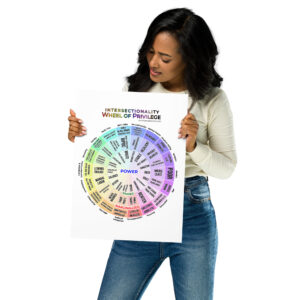
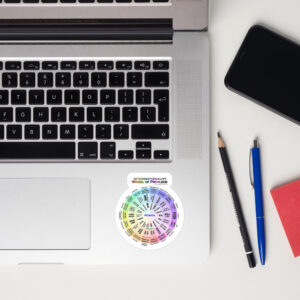
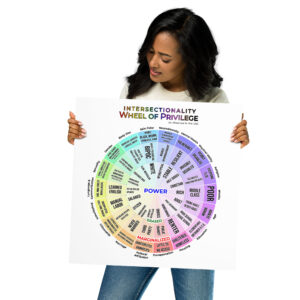
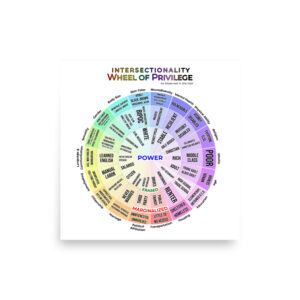

Thank you for creating this powerful version of the power/privilege wheel.
I will be leading a small conflict resolution workshop in July as part of a (non-profit) Quaker gathering and would like to include the Wheel image with the materials, of course including a credit/link to this website. Please let me know if you have any objection. (There is no materials charge for the workshop.)
Sure thing! Hope it goes well!
Dahooja Tessa,
I am blown away by the research and effort you put into adapting the Wheel of Power/Privilege to create your Intersectionality Wheel of Privilege graphic! I wonder if I may:
1. include it in with my definition of “intersectionality” in the Glossary of Terms for a course I am taking (Thompson River University SOCI 3991)?
2. cite it as follows: “Watkins, T. Intersectionality: Wheel of Privilege (as observed in the USA). (2023, January 13). Adapted from Sylvia Duckworth, Canadian Council for Refugees, and Olena Hankivsky, PhD. Retrieved from: https://just1voice.com/advocacy/wheel-of-privilege/” ?
3. Share it with my colleagues at work (I am a Kindergarten teacher)?
Thank you for your time, as well as for sharing your very thoughtful and detailed Intersectionality Wheel of Privilege!
Chera 🙂
Absolutely! Thank you so much for your kind words and definitely for the effort you’re putting into educating yourself and others! This is the kind of stuff I love to see 🥰
Thank you so much, Tessa 🙂
Really good overall, but I was a bit shocked that prisoners were not included. Prison family members too.
They are the most marginalized group in our society.
Ex-prisoners would fit into “erased” – there are still a lot of things off limits to them.
Valid point! Those currently in jail are definitely marginalized. I have some friends who are deeply passionate about prison reform and I’m shocked I didn’t think of it either! Thank you for the reminder.
Hi Tessa,
I absolutely love this and feel you have captured some previously overlooked aspects of identity that are vital in our udnerstanding of power and privilege. Would you be happy for me to reference your work in a doctoral assignment?
Many thanks!
Yes, absolutely! I’d love to see the finished assignment too if possible, sounds awesome!
I work at a psychiatric hospital. Can I make large copies to share with staff and patients?
Yes! I have posters for sale in my online shop here: https://just1voice.com/shop/tags/wheel-of-privilege/
Hi Tessa,
I’m an Equality, Diversity and Inculsion Lead for my NHS organisation in the UK.
I absolutely love this illustration of intersectionality. I would you consent to me putting it in our education resources for our staff?
Full reference and credit will be provided. We’ll make sure a link to this page is included.
I also wonder you would be happy for me to amend some of the text as we use different terminologies in the UK/have different systems in place? I’m happy to send you an email of what it would look like if you would be comfortable with that?
Thank you,
Bess
Yes of course! I’d love to see how you amend it when you’re done 🙂 Thanks!
Similar to Bess, I am working on some inclusion education at my company and want to ask permission to use this wheel as a resource with full reference and credit being provided. Are you comfortable with that?
Thank you for creating such a rich visual that is comprehensive and visually appealing all in one. I am grateful for all the amazing work that is being done in the diversity, equity and inclusion space to make the world a better place for all.
Thank you,
Kristi
Yep! I’m totally comfortable with that! Thank you for educating your company!